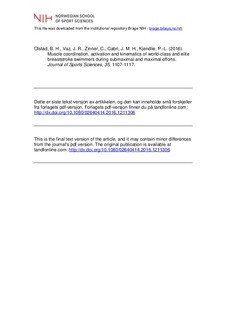| dc.contributor.author | Olstad, Bjørn Harald | |
| dc.contributor.author | Vaz, Joao Rocha | |
| dc.contributor.author | Zinner, Christoph | |
| dc.contributor.author | Cabri, Jan | |
| dc.contributor.author | Kjendlie, Per-Ludvik | |
| dc.date.accessioned | 2018-01-31T11:21:33Z | |
| dc.date.available | 2018-01-31T11:21:33Z | |
| dc.date.issued | 2016-07-25 | |
| dc.identifier.citation | Journal of Sports Sciences. 2016, 35, 1107-1117 | nb_NO |
| dc.identifier.uri | http://hdl.handle.net/11250/2480917 | |
| dc.description | I Brage finner du siste tekst-versjon av artikkelen, og den kan inneholde ubetydelige forskjeller fra forlagets pdf-versjon. Forlagets pdf-versjon finner du på tandfonline.com / In Brage you'll find the final text version of the article, and it may contain insignificant differences from the journal's pdf version. The definitive version is available at tandfonline.com | nb_NO |
| dc.description.abstract | The aims of this study were to describe muscular activation patterns and kinematic variables during the complete stroke cycle (SC) and the different phases of breaststroke swimming at submaximal and maximal efforts. Surface electromyography (sEMG) was collected from eight muscles in nine elite swimmers; five females (age 20.3 ± 5.4 years; Fédération Internationale de Natation [FINA] points 815 ± 160) and four males (27.7 ± 7.1 years; FINA points 879 ± 151). Underwater cameras were used for 3D kinematic analysis with automatic motion tracking. The participants swam 25 m of breaststroke at 60%, 80% and 100% effort and each SC was divided into three phases: knee extension, knee extended and knee flexion. With increasing effort, the swimmers decreased their SC distance and increased their velocity and stroke rate. A decrease during the different phases was found for duration during knee extended and knee flexion, distance during knee extended and knee angle at the beginning of knee extension with increasing effort. Velocity increased for all phases. The mean activation pattern remained similar across the different effort levels, but the muscles showed longer activation periods relative to the SC and increased integrated sEMG (except trapezius) with increasing effort. The muscle activation patterns, muscular participation and kinematics assessed in this study with elite breaststroke swimmers contribute to a better understanding of the stroke and what occurs at different effort levels. This could be used as a reference for optimising breaststroke training to improve performance. | nb_NO |
| dc.language.iso | eng | nb_NO |
| dc.publisher | Taylor & Francis | nb_NO |
| dc.subject | swimming | nb_NO |
| dc.subject | electromyography | nb_NO |
| dc.subject | motion analysis | nb_NO |
| dc.subject | 3D | nb_NO |
| dc.subject | biomechanics | nb_NO |
| dc.title | Muscle coordination, activation and kinematics of world-class and elite breaststroke swimmers during submaximal and maximal efforts | nb_NO |
| dc.type | Journal article | nb_NO |
| dc.type | Peer reviewed | nb_NO |
| dc.description.version | acceptedVersion | nb_NO |
| dc.source.journal | Journal of Sports Sciences | nb_NO |
| dc.identifier.doi | 10.1080/02640414.2016.1211306 | |
| dc.description.localcode | Seksjon for fysisk prestasjonsevne / Department of Physical Performance | nb_NO |
